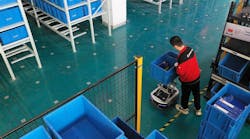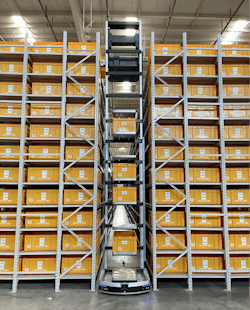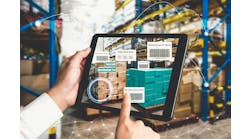A decade after Amazon created headlines when they purchased Kiva Robotics, third-generation autonomous mobile robots (AMRs) are taking the market by storm. These latest goods-to-person (G2) solutions store and retrieve products and SKUs in a more efficient way in high-speed picking applications. Robotic-based G2P are now available from firms such as Geek+, Addverb, Grey Orange and many other vendors worldwide.
Robotic-based G2P systems adoption is growing rapidly as they become more cost-effective for warehouses as a viable automation investment to improve picking and lower labor costs. As a result, G2P and AMRs are the fastest growing product segment in the material handling automation space, with AMRs for the first time outselling automated guided vehicles (AGVs) in 2021.
Robotic-based G2P storage and picking systems are now within the budget of small, medium and large businesses. For example, if a firm has 3,000 to 4,000 orders a day and 3,500 or more SKUs with a variable velocity movement mix, their distribution center (DC) operation could fit a small-size robotic G2P solution. As a result, these automation solutions can be an effective tool for companies aiming to reduce order fulfillment picking and replenishment labor costs in B2B, e-commerce and omni-channel order fulfillment operations.
Design First to Determine and Outline the DC's Needs
Successful warehouse automation initiatives should begin with a roadmap created after an engineering design study to define and determine the right blend of automation technologies and software requirements needed to accomplish the project goals. Before deploying automation technology like a G2P solution, any business should execute its due diligence. This process will compare and contrast the performance of various G2P systems’ capabilities with alternative types of warehouse automation using automated conveyor picking systems and pick-to-light and pick-by-voice or AMR batch cart order picking systems.
An engineering design study will compare the different solutions and define the proper blend of pick, pack and ship automation and the ROI of a goods-to-person investment. For example, a warehouse with 300 to 400 high-velocity moving SKUs may be better served by a system that stores and picks the highest velocity items from carton flow or pallet positions along a conveyor line. The blend of a high-speed pick line and a G2P system can help optimize the performance efficiency of the automated picking and storage system.
During the selection process, other important factors to consider, especially with rising warehouse facility rental costs, are optimizing the facility’s building height with technologies that can efficiently store and pick products from the floor to the ceiling. In addition, warehouse storage automation technologies are increasingly using denser and higher storage capacity technologies to extend the life of existing facilities and reduce the required building footprint for new DCs.
Gone are the days when warehouse operations could remain competitive by relying on a manual paper-based order fulfillment operation. Paper-directed pick, pack and ship processes are labor-intensive and error-prone due to their reliance on people making decisions, duplicated non-value-added manual touches, and the need for quality checks due to low accuracy practices. As a result, a DC using labor-intensive manual processes faces an uphill battle to remain competitive.
G2P Picking Performance Rises
The de facto standard rate obtainable from the latest generation robotic G2P picking systems is between 250 to 350 items per person-hour at a pick station, with picking accuracy of 99.8% or better. This speed and accuracy are critical in a same-day order fulfillment operation to meet e-commerce and B2B customer same-day delivery demands.
AI robotic software advancements are helping to drive performance gains. These are accomplished by continuously looking at SKU velocity movement to optimize and automate the product storage slotting locations, reducing the robots’ internal movement, and presenting a batch of orders to the picking stations to achieve worker pick rates of 250 to 300+ lines per hour.
Coupling the G2P system with a Tier 1 warehouse execution system (WES) can enable the G2P to achieve ROI typically within a two-year time frame by:
• Analyzing the daily order profile.
• Select and execute order prioritization rules.
• Calculating the right size shipping cartons based on SKU weights, cube and shipping methods.
• Managing the flow of orders into and out of the G2P system, the G2P can achieve an ROI typically within a two-year time frame.
The latest generation robotic G2P systems have advanced rapidly over the last two years and are now approaching the performance level of traditional shuttle systems, exceeding the performance of mini-load crane-based storage systems. However, the original generations of tote- and case-based shuttle systems and mini-load storage and picking systems are more expensive as precision steel, international shipping and installation costs continue to rise. These costs increase capital investments and can extend the ROI to five or more years.
Further, traditional shuttle systems based on rail and fixed aisle picking shuttle carts storage systems deliver fast performance but suffer from a higher cost per storage position and lack the flexibility and scalability of current robotic G2P solutions. While traditional G2P solutions come with higher equipment and installation costs and longer delivery and commissioning time, the latest robotic G2P solutions overcome these limitations and are more cost-effective.
Innovation in Shuttle Design
The advancement in performance and cost accelerates through the innovation of using two or more different task-oriented robots within the same G2P system. This is essentially a divide-and-conquer design approach within the next generation of robotic G2P systems.
Robots utilize a more adaptive and cost-effective means to store and pick products. The latest generation hybrid G2P systems with robots travel at higher speeds, handle more weight, and reach higher, denser storage shelves than the robotic G2P systems from just a few years ago.
A major innovation in robotic shuttle design provides a high-performance, high-density G2P solution that rivals the performance of a traditional tote shuttle system without the high infrastructure investment and costly expansion costs. The box- and tote-carrying robots use a modular, scalable design. Teams of different types of robots work together to store, pick and move products while increasing a DC’s facility space utilization.
These solutions combine two families of robots: the high-reach box- and tote-carrying and moving robots that can reach heights of 8 meters/26 feet for automatically storing and picking totes and cases. These robots include a depth camera and other sensors and use QR code-based navigation to move throughout the picking and storage aisles.
The G2P bots can autonomously pick and transfer up to eight totes to floor pick-up locations to move to the picking station. In addition, the robots handle large capacity tote weights up to 85 lbs. in dense double-deep racking.
The secret to the boost in performance is using the second family of small and nimble tote-carrying bots teamed with the high-reach picking and storage bots. The small shuttle bots travel in separate pick-up and delivery aisles from the high reach picking and storage bots at the bottom level, inside the four tote or box storage racking.
When the high reach bot completes the picking of a group of totes and boxes, it moves and inserts the tote into a floor-level pick-up position. This action triggers a message to dispatch the small shuttle bots to travel to the picking location, pick-up, and move the tote to the required picking station. The same process moves totes from the receiving replenishment area to the required storage aisles.
The dedicated purpose-built tote-carrying bots increase the speed totes can be moved to the operator pick stations, resulting in tote delivery rates of 300-400 totes an hour within the robotic G2P solutions. The faster pick rates and higher storage density capacity combine to provide an ROI of 24 to 30 months, half the time of a traditional tote shuttle storage and picking solution.
Additionally, robotic-based G2P solutions have inherent redundancy due to no single point of failure and do not require a full-time skilled on-site maintenance staff to operate. The simplified maintenance reduces high yearly operating costs, making these G2P solutions an affordable investment for small to mid-sized warehouse operations.
G2P and AMR-based picking and storage solutions combined with the right blend of traditional conveyor systems and pack and ship automation reduce touches and increase order flow across the entire order fulfillment operation. A business embarking on any automation initiative, especially a G2P- or an AMR-based picking solution, needs a design-first approach to analyze, select and justify the right mix of technologies. This approach should happen in partnership with an independent warehouse automation integrator that evaluates technologies and recommends the right blend of technologies to provide a solution with the greatest efficiencies.
The entire warehouse pick, pack and ship system performs at the highest level when orchestrated by a warehouse execution and control system software platform. This software manages and optimizes order release for G2P and the other warehouse automation technologies that increase productivity, lower manual labor dependency, and generate a rapid return on investment.
Dan Hanrahan is the president and founder of the Numina Group, a warehouse software development and independent automation solution system integrator. He and his software and engineering team at Numina Group have over 35 years of warehouse material handling, software, control and process improvement expertise.




